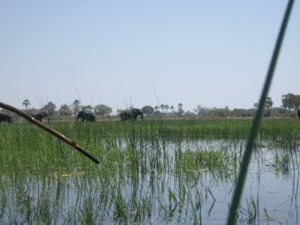
- Image via Wikipedia
Thomas L. Friedman
Who knew that deep in Botswana’s Okavango Delta, where there are no paved roads, phones or TVs, you could find the morning paper waiting for you every day outside your tent, with the latest news, weather and sports? Who knew?
True, this is no ordinary journal. The newspaper here on the Jao Flats of the northwest Okavango flood plain is published on the roads — literally. The wetlands are bisected by hippo trails and narrow roads made from pure white Kalahari Desert sand. And every morning, when you set out to investigate the wilderness, it is not uncommon for a guide to lean out of his jeep, study the animal and insect tracks, and pronounce that he’s “reading the morning news.”
We were lucky to be accompanied by Map Ives — the 54-year-old director of sustainability for Wilderness Safaris, which supports ecotourism in Botswana — and it was fascinating to watch him read Mother Nature’s hieroglyphics.
This day’s “news,” Ives explained, studying a stretch of road, was that some lions had run very quickly through here, which he could tell by the abnormal depth of, and distance between, their paw prints. They were in stride. The “weather” was windy coming out of the east, he added, pointing to which side of the paw prints had been lightly dusted away. Flood waters remained high this morning, because the nearby hyena tracks were followed by little indentations — splashes of water that had come off their paws. Today’s “sports”? Well, over here — the hyenas were dragging a “kill,” probably a small antelope or steinbok, which is very obvious from the smooth foot-wide path in the sand that ran some 50 yards into the bushes. Every mile you can read a different paper.
It is mentally exhausting hanging with Ives, who was raised on the edge of the Okavango Delta. He points out the connections, and all the free services nature provides, every two seconds: Plants clean the air; the papyrus and reeds filter the water. Palm trees are growing on a mound originally built by termites. Yes, thank God for termites. All of the raised islands of green in the delta were started by them. The termites keep their mounds warm. This attracts animals whose dung brings seeds and fertilizer that sprout trees, making bigger islands. Ives will be talking to you about zebras and suddenly a bird will zip by — “greater blue-eyed starling,” he’ll blurt out in midsentence, and then go back to zebras.
“If you spend enough time in nature and allow yourself to slow down sufficiently to let your senses work, then through exposure and practice, you will start to sense the meanings in the sand, the grasses, the bushes, the trees, the movement of the breezes, the thickness of the air, the sounds of the creatures and the habits of the animals with which you are sharing that space,” said Ives. Humans were actually wired to do this a long time ago.
![Reblog this post [with Zemanta]](http://img.zemanta.com/reblog_b.png?x-id=b95fcded-deb4-421b-99d5-b99a66ed4449)








